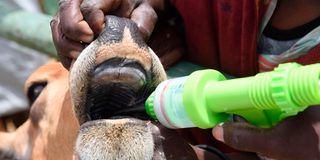Beware of worm drugs resistance and re-infestation

A cow being dewormed at Tsangasini livestock sales yard in Kilifi on November 1, 2021.
Worm treatment and prevention drugs are called wormicides, dewormers or worming medicines. Scientifically they are called anthelmintics or internal parasiticides. The drugs are classified as over the counter medicines or OTCs. Drugs sold by prescription only are called prescription only medicines or POMs.
Dewormers are some of the most commonly used medicines for livestock. Incidentally, they are also some of the most commonly misused drugs. In addition, they cost farmers lots of money for being ineffective, animals dying despite treatment and wastage because in most cases they are packaged in multiple doses while most farmers have fewer animals than the minimum dose packages.
Dewormers fail to work because of giving lower than the required dose, giving the wrong dewormer for the worms causing disease and worms developing resistance to a particular drug.
While farmers are allowed to buy dewormers over the counter, it is advisable to have a deworming programme based on knowledge of the worms found in specific areas or the areas where farmers acquire livestock from. The information can be provided by the animal health service providers in the farmers’ locations.
Most farmers will rush to deworm animals when they see them not performing well in production, growth and maintenance of good body condition. While presence of worms in the animal may cause the observed deficiencies, it is not the only possible cause. It is, therefore, advisable for farmers to have and stick to their deworming programmes but get specific diagnosis from their animal health service providers when they notice changes in the animals’ performance, despite executing the deworming programme.
The presence of worms in the animal is called worm infestation or helminthiasis. Most worm medicines do not remain active in the body for long periods of time. Therefore animals may be re-infested with worms as early as two weeks from the last deworming.
Further, most worms do not induce immunity in the host animal like many bacteria and viruses do. However, some adult animals, especially cattle, develop resistance to some worm infestations and fail to show disease even when they have worms. This resistance could be due to the size of the animal relative to the worm because worms mainly cause disease by denying the host nutrients and sucking blood.
Farmers should always be aware that worms can develop resistance to certain drugs and that re-infestation of the animal with worms can occur even before the recommended three-month deworming period.
Re-infestation depends on the age of the animals, the parasite load in the animals’ feeding environment and the environmental conditions. Most worms suspend their development during unfavourable weather such as extreme cold and dryness but become very active during the warm wet periods. It is for that reason that animals do not appear to be affected by worms during the dry seasons but get heavily affected in the wet warm seasons.
Last week I had a complaint from David who farms sheep and goats in Nairobi. He said he had dewormed his goats and sheep with albendazole three weeks earlier but some still appeared to have worms. He wanted me to prescribe a dewormer that would eliminate all the worms.
I explained to David that his case needed my visit to examine the animals and determine whether his problem was really worms or something else. On arrival at the farm, I noticed most of the animals were in good body condition but a sheep and one goat looked sickly and had diarrhoea.
David informed me one sheep had been treated for bacterial diarrhoea a week earlier but it had died. I examined the sick sheep and found it barely had any blood in its system but all other parameters were normal. The linings of the eye and gums, called mucous membranes, were extremely pale. The eyes were white instead of the normal pink.
The goat also had a moderate degree of the same condition as the sheep. I explained the animals had anaemia. From experience and estimation of the blood level, I explained to David the sheep would most likely die even if I treated.
I suspected the animals had heavy worm infestation with a type of worm called Haemonchus contortus, commonly called the Barber’s Pole worm or Candy Pole worm. Meat from an animal infested by the worm is fit for human consumption.
I suggested to David we slaughter the sheep, confirm the diagnosis and treat the other animals for the worms. If I treated the sheep and it died, the meat would have gone to waste.
After slaughter, my diagnosis was confirmed by the presence of the tiny slender worms in the abomasum. This is the fourth compartment of the sheep’s stomach which is equivalent to the human stomach in shape and function.
The worms were there in large numbers,. They looked like cotton strands with red streaks of blood visible in the whole length of their digestive tract. The abomasum also contained blood that had passed whole through the worms’ gut.
Haemonchus contortus is a killer of sheep and goats. When present in large numbers, it quickly sucks lots of blood and the animal dies of blood shortage or anaemia. If the worm numbers are small, an animal progressively loses weight and becomes anaemic. The neck gets swollen with fluid because the blood is low in proteins and the animal eventually dies.
In the next article, I will explain how to manage this tiny but problematic blood thief of sheep and goats.





